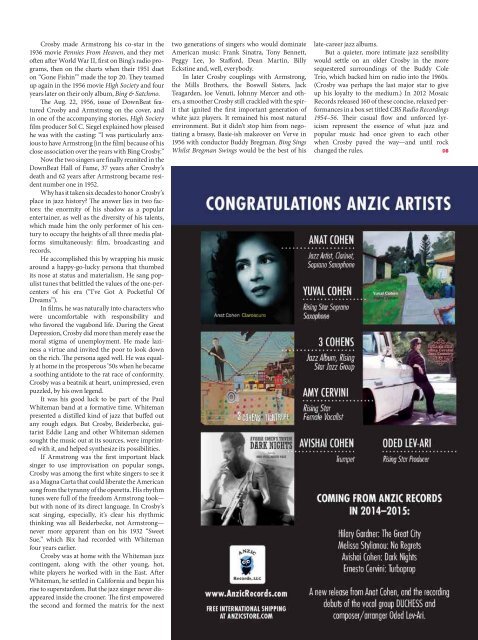You also want an ePaper? Increase the reach of your titles
YUMPU automatically turns print PDFs into web optimized ePapers that Google loves.
Crosby made Armstrong his co-star in the<br />
1936 movie Pennies From Heaven, and they met<br />
often after World War II, first on Bing’s radio programs,<br />
then on the charts when their 1951 duet<br />
on “Gone Fishin’” made the top 20. They teamed<br />
up again in the 1956 movie High Society and four<br />
years later on their only album, Bing & Satchmo.<br />
The Aug. 22, 1956, issue of DownBeat featured<br />
Crosby and Armstrong on the cover, and<br />
in one of the accompanying stories, High Society<br />
film producer Sol C. Siegel explained how pleased<br />
he was with the casting: “I was particularly anxious<br />
to have Armstrong [in the film] because of his<br />
close association over the years with Bing Crosby.”<br />
Now the two singers are finally reunited in the<br />
DownBeat Hall of Fame, 37 years after Crosby’s<br />
death and 62 years after Armstrong became resident<br />
number one in 1952.<br />
Why has it taken six decades to honor Crosby’s<br />
place in jazz history? The answer lies in two factors:<br />
the enormity of his shadow as a popular<br />
entertainer, as well as the diversity of his talents,<br />
which made him the only performer of his century<br />
to occupy the heights of all three media platforms<br />
simultaneously: film, broadcasting and<br />
records.<br />
He accomplished this by wrapping his music<br />
around a happy-go-lucky persona that thumbed<br />
its nose at status and materialism. He sang populist<br />
tunes that belittled the values of the one-percenters<br />
of his era (“I’ve Got A Pocketful Of<br />
Dreams”).<br />
In films, he was naturally into characters who<br />
were uncomfortable with responsibility and<br />
who favored the vagabond life. During the Great<br />
Depression, Crosby did more than merely ease the<br />
moral stigma of unemployment. He made laziness<br />
a virtue and invited the poor to look down<br />
on the rich. The persona aged well. He was equally<br />
at home in the prosperous ’50s when he became<br />
a soothing antidote to the rat race of conformity.<br />
Crosby was a beatnik at heart, unimpressed, even<br />
puzzled, by his own legend.<br />
It was his good luck to be part of the Paul<br />
Whiteman band at a formative time. Whiteman<br />
presented a distilled kind of jazz that buffed out<br />
any rough edges. But Crosby, Beiderbecke, guitarist<br />
Eddie Lang and other Whiteman sidemen<br />
sought the music out at its sources, were imprinted<br />
with it, and helped synthesize its possibilities.<br />
If Armstrong was the first important black<br />
singer to use improvisation on popular songs,<br />
Crosby was among the first white singers to see it<br />
as a Magna Carta that could liberate the American<br />
song from the tyranny of the operetta. His rhythm<br />
tunes were full of the freedom Armstrong took—<br />
but with none of its direct language. In Crosby’s<br />
scat singing, especially, it’s clear his rhythmic<br />
thinking was all Beiderbecke, not Armstrong—<br />
never more apparent than on his 1932 “Sweet<br />
Sue,” which Bix had recorded with Whiteman<br />
four years earlier.<br />
Crosby was at home with the Whiteman jazz<br />
contingent, along with the other young, hot,<br />
white players he worked with in the East. After<br />
Whiteman, he settled in California and began his<br />
rise to superstardom. But the jazz singer never disappeared<br />
inside the crooner. The first empowered<br />
the second and formed the matrix for the next<br />
two generations of singers who would dominate<br />
American music: Frank Sinatra, Tony Bennett,<br />
Peggy Lee, Jo Stafford, Dean Martin, Billy<br />
Eckstine and, well, everybody.<br />
In later Crosby couplings with Armstrong,<br />
the Mills Brothers, the Boswell Sisters, Jack<br />
Teagarden, Joe Venuti, Johnny Mercer and others,<br />
a smoother Crosby still crackled with the spirit<br />
that ignited the first important generation of<br />
white jazz players. It remained his most natural<br />
environment. But it didn’t stop him from negotiating<br />
a brassy, Basie-ish makeover on Verve in<br />
1956 with conductor Buddy Bregman. Bing Sings<br />
Whilst Bregman Swings would be the best of his<br />
late-career jazz albums.<br />
But a quieter, more intimate jazz sensibility<br />
would settle on an older Crosby in the more<br />
sequestered surroundings of the Buddy Cole<br />
Trio, which backed him on radio into the 1960s.<br />
(Crosby was perhaps the last major star to give<br />
up his loyalty to the medium.) In 2012 Mosaic<br />
Records released 160 of these concise, relaxed performances<br />
in a box set titled CBS Radio Recordings<br />
1954–56. Their casual flow and unforced lyricism<br />
represent the essence of what jazz and<br />
popular music had once given to each other<br />
when Crosby paved the way—and until rock<br />
changed the rules.<br />
DB<br />
AUGUST 2014 DOWNBEAT 37


